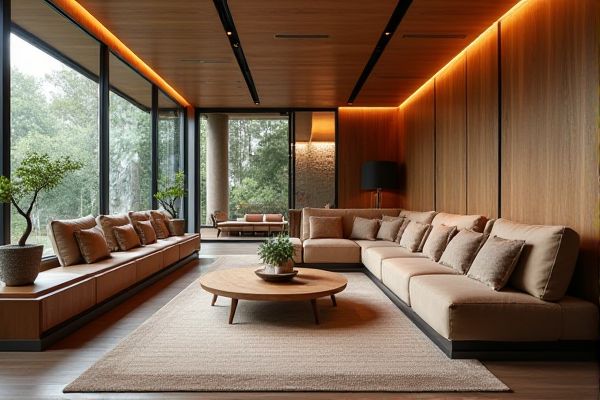
Corner seating maximizes space efficiency by utilizing room corners, creating cozy and intimate areas, while linear seating offers a streamlined, versatile arrangement ideal for open spaces and larger gatherings. Explore the article to discover which seating option best enhances Your living or workspace.
Table of Comparison
| Feature | Corner Seating | Linear Seating |
|---|---|---|
| Space Efficiency | Maximizes corner space, ideal for compact rooms | Uses straight wall space, suits long rooms |
| Seating Capacity | Provides more seating in tight areas | Offers uniform seating along a single line |
| Social Interaction | Enhances face-to-face communication | Promotes linear, less interactive seating |
| Design Flexibility | Fits various room shapes and angles | Best for open, rectangular layouts |
| Installation Complexity | May require custom fitting | Generally easier and more standard |
| Common Uses | Living rooms, lounges, small dining areas | Waiting rooms, cafeterias, long dining tables |
Introduction to Corner Seating and Linear Seating
Corner seating maximizes space utilization by fitting snugly into room angles, creating an intimate and cozy atmosphere that enhances social interactions. Linear seating provides a straightforward, streamlined layout ideal for rooms with limited space or minimalist design preferences, offering clean lines and flexibility in arrangement. Your choice between corner seating and linear seating will impact room flow, comfort, and the overall aesthetic appeal tailored to your living space needs.
Defining Corner Seating: Features and Benefits
Corner seating features an L-shaped design that maximizes space utilization by fitting snugly into room corners, creating a cozy and intimate seating area. Its structure provides enhanced comfort with extended seating capacity, making it ideal for social gatherings and family rooms. The ergonomic layout promotes efficient room flow and versatile arrangements, blending style with functionality.
Understanding Linear Seating: Structure and Advantages
Linear seating offers a straightforward arrangement where seats are aligned in a single, continuous row, maximizing space efficiency in narrow or elongated areas. This structural design facilitates easy access and clear sightlines, making it ideal for environments like conference rooms or dining areas where interaction and visibility are key. Optimizing circulation and minimizing obstructions, linear seating supports functional layouts in both commercial and residential settings.
Space Optimization: Corner vs Linear Seating
Corner seating maximizes space utilization by fitting snugly into unused corners, creating a cozy yet efficient area ideal for small rooms or compact layouts. Linear seating requires more wall length, potentially limiting floor space and reducing overall room flexibility compared to corner arrangements. Choosing corner seating can help you optimize your room's square footage while maintaining comfortable seating capacity.
Comfort and Ergonomics Comparison
Corner seating provides enhanced ergonomic support by promoting natural body positioning and better weight distribution across multiple planes, reducing strain on the back and hips. Linear seating often limits posture variety, potentially leading to discomfort during extended use due to uneven pressure points. Ergonomic studies highlight corner configurations as superior for maintaining spinal alignment and enhancing overall comfort in lounge and office environments.
Aesthetic Appeal in Different Room Layouts
Corner seating enhances aesthetic appeal by maximizing space in compact or irregularly shaped rooms, creating cozy and inviting nooks. Linear seating offers a streamlined and modern look, ideal for open-plan layouts with elongated walls, emphasizing clean lines and spaciousness. Both styles can be tailored with fabric, color, and design choices to complement specific room dimensions and interior themes.
Flexibility and Functionality in Usage
Corner seating offers enhanced flexibility by maximizing space utilization in compact areas, creating cozy, intimate arrangements suitable for social interactions or relaxation. Linear seating provides straightforward functionality with versatile placement options, accommodating multiple users in alignment and ideal for formal or high-traffic environments. Both seating styles adapt to diverse settings, but corner seating excels in creating multifunctional zones while linear designs prioritize efficiency and ease of movement.
Cost Analysis: Corner Seating vs Linear Seating
Corner seating generally offers more efficient use of space, potentially reducing the number of furniture pieces needed and lowering overall costs compared to linear seating arrangements. Linear seating often requires additional elements such as side tables or extra chairs to maximize seating capacity, increasing expenses. Evaluating installation, material, and maintenance costs reveals that corner seating can provide better value for both residential and commercial spaces due to its compact design and multifunctional use.
Best Applications: When to Choose Each Seating Style
Corner seating is ideal for maximizing space in small or irregularly shaped rooms, creating intimate conversation areas perfect for living rooms or lounges. Linear seating suits long or narrow spaces such as hallways, dining rooms, or offices where alignment and streamlined flow are essential. Choosing between these styles depends on room layout, desired social interaction, and functionality requirements.
Conclusion: Making the Right Seating Choice
Choosing between corner seating and linear seating depends on your space layout and functional needs. Corner seating maximizes room utilization and encourages social interaction by facilitating face-to-face conversation, while linear seating offers a streamlined, versatile option ideal for narrow spaces and efficient traffic flow. Assess your room dimensions and how you intend to use the seating to make the most practical and stylish choice for your home or office.
 homyna.com
homyna.com